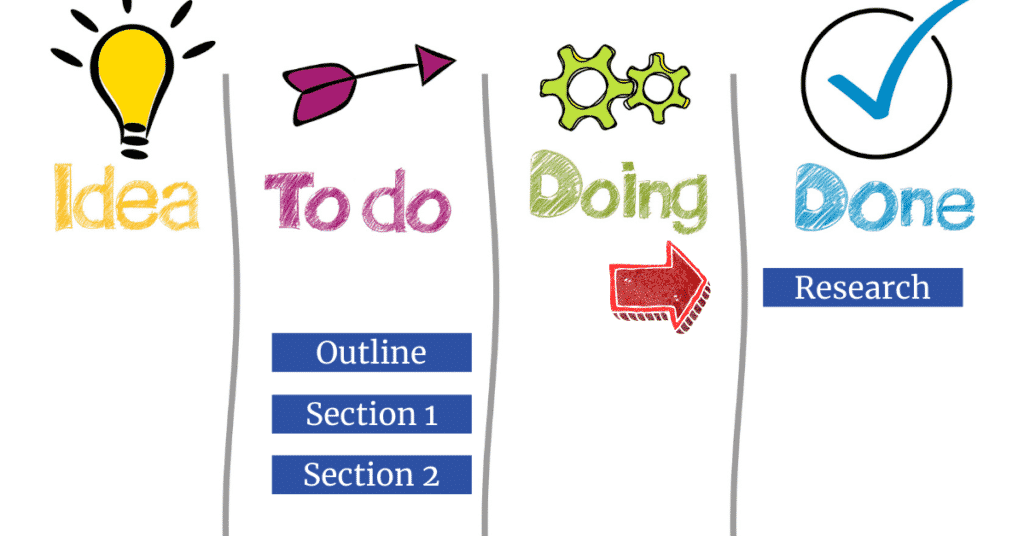Do you want to know how to BREAK down goals into steps?
If so, get ready. Because I’m going to share a simple system for how to break goals DOWN into smaller pieces. To make ANY goal manageable!
Topics discussed:
- WHY you should break goals into steps
- HOW to break down goals into steps (a simple system)
- 3 pro tips to keep in mind when breaking down your goals
- 2 FAQs for how to break down goals into steps
Why You Should Break Down Goals Into Steps (5 Benefits)
Here are 5 reasons why breaking goals into tasks can help you achieve your goals.
1. Breaking Down Goals Into Steps Makes You Less Likely to Procrastinate
If you break a goal into smaller pieces, the chances you procrastinate it drops dramatically.
That’s because you procrastinate when things seem HARD—> But breaking goals into tasks makes things seem EASIER.
Imagine your goal is to write a novel. There are 2 ways you can think of it:
- (A) You can view writing the entire book as 1 gigantic to-do list item.
- Or (B) You can break that novel into super small steps.
You are MUCH less likely to procrastinate option B (breaking the novel into small tasks). Simply because that seems far less intimidating.
Recommended Article: How to Stop Putting Off Work (& Get Stuff Done!)
2. It Helps Builds Momentum
Another reason why breaking goals into steps is so important, is that it helps create momentum.
Each step you complete makes it easier to tackle the steps that follow.
That’s because after each step, you:
- Build skills
- Acquire knowledge
- Learn lessons
- And gain confidence
That last point (gaining confidence) is one of the most critical.
Knocking that first step off your list (even a tiny one) often convinces you that you CAN achieve your goal.
And once you get a few steps under your belt, it’s all downhill from there!
3. Piecing Out Your Goals Improves Time Management
That’s for several reasons:
- First, it helps with prioritization: (A) It allows you to prioritize each task within the goal you are working on. And (B) It let’s you prioritize each specific component within your overall schedule.
- Second, it boosts productivity: That’s because you have the flexibility to fine tune WHEN you work on which tasks. In some cases, that means splitting tasks up. For example, saving a difficult task for when you are most energized. In other cases, you may want to batch tasks. Which involves knocking off similar tasks in the same time frame (more on this later).
- And third, it makes it easier to organize: When you break projects down into smaller parts, it is easier to record and visualize what you have to do. The specific organizational method is up to you (to-do list, note taking app, kanban board, etc.). But whatever your system is, you are going to need to divide up goals into smaller components.

Recommended Article: 17 Simple, Yet Highly Effective To-Do List Strategies
4. Breaking Goals Down Into Steps Reduces Stress & Anxiety
Sometimes, pursuing a goal can be really stressful. Especially if you are looking at it from a big picture perspective.
Things can seem overwhelming, because there is so much you need to learn and do.
But if you break goals down into smaller pieces, your mission becomes: “Just do the next task on my list.”
Which is going to give you FAR less anxiety than trying to tackle everything at once.
Recommended Article: 31 Ways to Stop Stressing Over Things You Can’t Control
5. It Forces You to Think Through the Details
Breaking goals into tasks forces you to detail out clear action items for how to get to your goal.
And the more SPECIFIC your plans are, the easier they are to carry out. That’s because being specific:
- Ensures you’ve carefully thought through your plan: At least enough to get started.
- Helps you transition from “dreaming” to “doing”: Dreaming about completing a goal can be fun, but is not particularly effective. Thinking through the details helps you shift to more of a process-focused mindset.
- Identifies knowledge gaps: As you write out the steps, you will notice any areas where you need more knowledge, research, or skill building.
Some people say “the devil is in the details,” but I think the truth is “the angel is in the details.”
I can’t tell you how often I used to spend dreaming about things I wanted to accomplish, but never actually followed through with those dreams.
It wasn’t until I started breaking those dreams down into small, actionable steps, that I began to make consistent progress towards those goals.
Why You Should Break Down Goals Into Steps Pt 2 (Video With Further Discussion)
If interested, here’s a discussion I had with programmer/blogger Nick Scialli on WHY breaking down goals into tasks is important.
Otherwise, keep reading to learn my system for exactly HOW to break down goals into steps.
How to Break Down Goals Into Steps (A Simple System)
Here is a simple system for how to break down goals into steps. Keep in mind, these are general guidelines. You are welcome to adjust things as needed based on your specific goals and preferences.
- Define Your Goal
First, clearly define the goal you want to focus on. The more specific your goal is the better.
- Determine What You Need to Do to Accomplish the Goal
At a high level, figure out what is necessary to reach your objective.
Depending on your specific goal, this could mean:
– Reading “how-to” articles.
– Asking someone for advice.
– Or something more formal, like taking a training course.
Keep in mind, you don’t need to figure out everything at this stage, just enough to get started. - Divide Your Goal Into High-Level Subgoals
Now, take your goal, and write down what you need to do to accomplish it.
Let’s say your goal is to find a job in programming. You might come up with the following high-level subgoals:
– Prepare resume
– Search for relevant programming jobs
– Apply to jobs
– Prepare for interviews
– (And if offered) Decide if you want to accept - Break the First Subgoal Into Smaller, Actionable Steps
Make each step as tiny and specific as possible.
Continuing with the example of finding a programming job, here’s how someone might divide up the first subgoal of “prepare resume.”
– Find old resume.
– Add school, major, and dates for latest degree earned.
– Note summer internship employer and dates.
– Write responsibilities under internship section.
– And update skills in “skills section.” - Plan When to Do the First Step
Next, decide when you are going to execute the first step on your list. You have 2 options:
(A) Execute it right away.
Or (B) Note when you plan to do it.
When possible, it can be helpful to knock it off immediately, to create some momentum. But understandably that’s not always doable. - Execute, Repeat, and Adjust as Needed
Finally, it’s time to execute your game plan. And then repeat everything discussed for the remaining steps on your list.
If needed, don’t be afraid to make adjustments along the way.
3 Pro Tips to Keep in Mind When Breaking Down Your Goals
Here are 3 tips for how to break down goals into steps, which are very important to factor in.
Pro Tip Number 1: Make Sure the Steps Are Small Enough
Making steps small REDUCES the risk of:
- Getting overwhelmed
- Or burning out
Small steps INCREASE the chance you:
- Form habits
- Build momentum
- And ultimately stick with your goal
Breaking down goals into small pieces also makes it easier to prioritize those tasks within your overall schedule.
Exactly how small is going to depend on your specific goal and preferences. (More on that later).
Pro Tip Number 2: You Don’t Have to Plan Out EVERYTHING Ahead of Time
In the past, I used to spend a lot of time procrastinating things. And one of the biggest causes, was that I felt like I needed to have EVERYTHING figured out to get started.
Of course, there are times you truly DO need to have a perfect understanding of things to get going. Like if safety is involved.
And some degree of planning can definitely help make the process more efficient.
But in 90% of situations I’ve found I can usually get started on something, EVEN if I don’t have things 100% planned out.
Getting started, and learning as you go, has a few advantages:
- First, it prevents procrastination.
- Second, you often learn more by DOING than you ever could by planning alone.
- And third, it creates momentum. Which can give you the confidence to keep pursuing your goal.
Once you reach a point where you can’t progress any further, THEN you can do additional research and plan out the remaining steps.
Recommended article: Why You Procrastinate Important Things (And How to Stop)
Pro Tip Number 3: Batch Tasks When Able
Some productivity studies suggest it may be more efficient to do similar tasks in the same time frame.
For instance, in the “prepare resume” example discussed earlier, perhaps you do the following steps back-to-back:
- “Write responsibilities under internship section.”
- And “update skills in skills section.”
This could be more efficient, because thinking about your internship responsibilities might spark some ideas for skills to add.
That said, you don’t want to OVER-batch. If you put too much on your plate, it increases the chances you will procrastinate things or get overwhelmed.
2 FAQs For How to Break Down Goals Into Steps
Finally, here are my answers to 2 questions I get asked a lot when it comes to breaking down goals into smaller tasks.
FAQ #1: For Goals That Don’t Have an End Point, Like Exercising, Do I Have to Write Down Every Step Forever?
The answer is, not necessarily! Once you’ve repeated the steps many times, they will become wired into your brain as habits.
At that point, you have a few options:
- CONTINUE to write every step down: Just to make sure you don’t miss anything.
- Don’t write ANYTHING down: If you are 100% sure you have a habit firmly established.
- Or ONLY write down the higher-level subgoals: A balanced approach, where you stop writing down every detail.
The latter is a strategy I use frequently.
At first, I write down every small step. But every several weeks, I re-assess how things are going.
If I find myself naturally completing steps without even having to look at what I’ve written, I start to roll those little steps up.
And just write down the higher-level subgoals.
FAQ #2: How Long Should Each Step Take?
There is no exact amount of time each step needs to be. It’s going to vary.
But here’s the rule of the thumb: When you are first starting out, the smaller the better.
Also, if you struggle with procrastination, it’s even more important to err on the smaller side.
That’s because the smaller the steps are, the less intimidating they are to get started with.
Personally, for a new goal, I like each step to be roughly:
- A maximum of an hour.
- But usually 30 minutes or less.
- And sometimes as small as 1 to 5 minutes.
But these aren’t hard rules by any means!
Also, as I mentioned earlier, as things become habits, you may decide to just plan out the higher-level subgoals. Which will take up larger blocks of time.
Free “How to Break Down Goals Into Steps” Cheat Sheet







